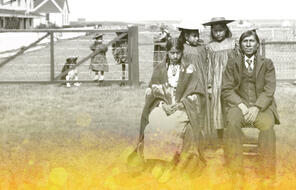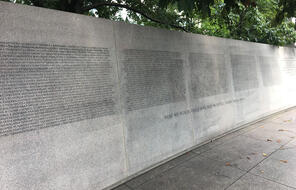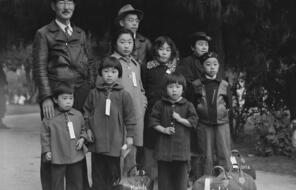Who Is To Blame?
Government officials, school administrators, clergymen and women, and laymen associated with the running of the residential schools were not the primary focus of the Truth and Reconciliation Commission. But the abuses committed by individuals and institutions formed a central part of the testimony provided by survivors and their families and supporters. By and large, individual perpetrators were not named at Truth and Reconciliation Commission events, although their crimes and abuses were the subject of many, if not all, of the testimonies given. In several public events, members of different churches and government officials did appear in person and offered apologies. 1
To some, the absence of testimony from the people who were in charge of running the schools points to a great weakness. President of the Métis National Council Clément Chartier appeared at several Truth and Reconciliation Commission events. 2 At the Saskatoon National Event held on June 22, 2012, he said: “To reach full reconciliation there has to be two parties. It can’t just be the Métis nation speaking to itself.” 3
In the absence of perpetrators, many survivors feel that reconciliation at this stage can only be an internal process with the hope that other forms of reconciliation will follow. As the Regional Chief for Newfoundland and Nova Scotia, Morley Googoo, said in a gathering of the Outreach Residential School Atlantic Committee, “We have to reconcile among ourselves.” 4
Justice Murray Sinclair, one of the commissioners and Chair of the Truth and Reconciliation Commission, explains this stage as follows:
Reconciliation is about establishing a respectful relationship between Aboriginal and non-Aboriginal people. Before we can have mutual respect, we have to understand the importance of ensuring that Aboriginal people in future generations have self-respect. That’s a difficult thing to do because it involves undoing a lot of things that are founded on the racism of the past . . . [T]hat this history of oppression, of taking away from Aboriginal people their faith in themselves, their belief in their systems and culture, their ability to speak their language, their understanding of their own history, has resulted in a population of young Indigenous people who are not only angry and frustrated [but] also feeling at a loss because they want those things put back into their lives. They want to know what it means to be Anishinaabe, they want to know what it means to be a Cree, to be a Dene, to be a Dakota. 5
Fred Kelly, a residential school survivor who was a member of the indigenous team that negotiated the settlement agreement, thinks about reconciliation this way: “Blame for forced attendance in a residential school and the terrible experiences must be directed somewhere. Certainly there is blame, but rather than vengeance, the Survivor seeks an understanding of what transpired. The person makes peace with himself or herself. . . . More than anything else, one must forgive oneself.” 6 Kelly offers this public statement of reconciliation regardless of whether he is able to meet the people who ran the residential schools:
A government founded on peace, order, and good government and yet responsible for inflicting the horror of the residential school system is one that I am prepared to meet with to discuss the rule of law that includes enforcement of Aboriginal rights and treaties as the basis for a reconciled future. A church that validated the ruthless superiority complex of European monarchs to persecute Indigenous people, steal their land, and overrun their cultures by condemning them as ways of the devil is one I am also prepared to discuss reconciliation with. . . . A clergy abiding a faith founded on the teachings of Christ, who so loved the purity and innocence of children, yet whose own agents inflicted sexual and physical abuse on Aboriginal children are men and women I am prepared to meet in my community to discuss reconciliation. And should they still believe in hell, may they be spared. Yes, Father, I am prepared. In ultimate personal reaffirmation, it was not God that hurt generations of innocent children, but the human beings in the churches who undertook to deliver Christianity and inflicted the sorrow in His name. It is not my right or prerogative to forgive what was done to my brothers, my sisters, and my dearest friends as they must speak for themselves and, unfortunately, many of them are now dead. Nevertheless, I dedicate this statement of reconciliation to their memory. I can speak for myself, Father. 7
Connection Questions
- President of the Métis National Council Clément Chartier argued that “to reach full reconciliation there has to be two parties. It can’t just be the Métis nation speaking to itself.” What does he mean? What questions might you ask him?
- Morley Googoo, Regional Chief for Newfoundland and Nova Scotia, said in a gathering of the Outreach Residential School Atlantic Committee, “We have to reconcile among ourselves.” What do you make of this statement? Do you think that this view limits the scope of the reconciliation that can be achieved by the Truth and Reconciliation Commission?
- Fred Kelly provides the terms that make it possible for him to reconcile with the government and the church. What are they? Can they be applied more generally?
- Define the term perpetrator. Consider who you think was responsible for the crimes of the residential schools. Were all of those who were responsible perpetrators?
- 1Ronald Niezen notes that the commission “thoroughly extinguished the identities of possible perpetrators from its proceedings, preventing their names from even entering the record through survivor narratives, and maintaining their invisibility and anonymity all the way through [its] activities.” See Ronald Niezen, Truth and Indignation: Canada’s Truth and Reconciliation Commission on Indian Residential Schools (University of Toronto Press, 2010), 183–185, 221–223.
- 2Many Métis are excluded from the Truth and Reconciliation Commission proceedings and compensation agreements because the group wasn’t recognized as “Indian” and the majority of its youth did not attend the state-sponsored residential schools. The issue is now being debated in the courts
- MétisMétis: The term broadly describes descendants of mixed European and First Nations ancestry. In a narrow sense, Métis refers only to the descendants of First Nations people and French settlers in Manitoba. The history of the Métis reflects the intermingling of their different ways of life during the seventeenth- and eighteenth-century North American fur trade. Eventually, these descendants developed distinct language, culture, and traditions.
- 3Quoted in Ronald Niezen, Truth and Indignation.
- 4Chief Morley Googoo, statement to the Outreach Residential School Atlantic Committee, meeting under the auspices of the Atlantic Policy Congress of First Nations Chiefs Secretariat, Glooskap Heritage Centre, Millbrook, Nova Scotia, March 6, 2012. Quoted in Ronald Niezen, Truth and Indignation.
- 5“Reconciliation through Education,” Queen’s Gazette, March 30, 2015, accessed May 8, 2015. We thank David MacDonald for this and many other references.
- 6Fred Kelly, “Confession of a Born Again Pagan,” in From Truth to Reconciliation: Transforming the Legacies of Residential Schools (Aboriginal Healing Foundation, 2008), 3.
- 7Fred Kelly, From Truth to Reconciliation, 30. This and other testimonies were curated by the Aboriginal Healing Foundation.
How to Cite This Reading
Facing History & Ourselves, "Who Is To Blame?," last updated September 20, 2019.















